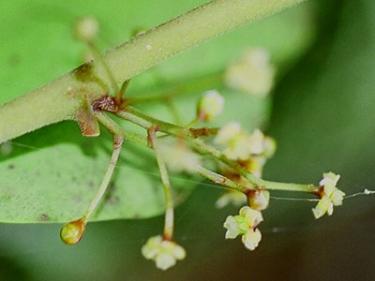
How, exactly, did flowering plants evolve from seed-bearing plants? Two centuries after Darwin’s birth, scientists are getting more answers

William (Ned) Friedman (at right) is a professor of evolutionary biology at the University of Colorado
Darwin’s book “On the Origin of Species” is the foundation of modern biology. Darwin was born 200 years ago, and while the mystery of flowering plants’ rapid ascendance is still not solved, scientists say some answers may not be far off.
Friedman notes that evolutionary biologists aren’t as close as they’d like to be in linking flowering plants with seed-bearing plants like ginkgoes and coniferous trees—which dominated Earth for about 250 million years but are now relatively minor players in the plant world.
Flowering plants, also called angiosperms, appeared about 130 million years ago and became dominant within 30 million years, which Friedman says is “the blink of an eye.” The impact of that development is huge.
The simple way to frame it, Friedman says, is to look out the window. Flowering plants are the majority of those we see. Furthermore, flowering plants produce most of the food we eat.
Towering groves of walnut, amber waves of grain, sprawling fields of tomatoes and 300,000 other species of flowering plants are central to nourishing human bodies and frame human life. Flowering plants evolved from gymnosperms like ginkgoes and conifers, which bear naked seeds.
Unlike conifers, however, flowering plants nourish their seeds with a tissue called endosperm, which results from a fertilization event that occurs at the same time the embryo is formed from a separate fertilization involving an egg and a sperm. The endosperm inside flowering plant seeds may produce starch, protein or fat. Endosperm makes up the majority of a grain of wheat, milk and meat of coconut and kernels of popcorn.

In this letter to a colleague, Charles Darwin referred to the apparently sudden rise of flowering plants as an "abominable mystery."
And while seed plants were a dominant component of plant life for a quarter-billion years, these non-flowering groups of seed plants now make up only about 3 percent of Earth’s flora.
From Darwin’s perspective, flowering plants appeared more quickly and spread more rapidly than he would have anticipated. The fossil record as Darwin knew it seemed to indicate that flowers appeared and burgeoned in a very brief period of the Cretaceous.

The Amborella plant. Photo courtesy of Thomas J. Lemieux, University of Colorado
This uneasiness prompted Darwin to muse over the “abominable mystery,” which are “probably the two most-famous words he ever uttered or wrote,” Friedman says.
But Darwin’s data were incomplete. The fossil record as it was then understood lacked 20 million years of data, Friedman notes.
“We now know that the earliest phases of angiosperm diversification, as witnessed in the fossil record, demonstrate a period of relatively gradual and orderly diversification prior to the mid-Cretaceous,” Friedman wrote in the January edition of the American Journal of Botany.
For modern evolutionary biologists, there is no monstrous mystery about the earliest phases of flowering plant diversification. But there remain many questions about why flowering plants have succeeded so well.
As Friedman suggests, posing that question is like asking why one corporation succeeds over another: Specifically, what innovations did one company employ that gave it a competitive advantage over a company that failed?
The answer seems to stem partly from the method of reproduction of flowering plants. Friedman does not think it is a coincidence that flowering plants became fruitful and multiplied after gaining the extra benefit of their special and unique embryo-nourishing tissue, endosperm, he told The New York Times this year.
“It’s like having a bigger engine,” he said.
Yet, while it’s becoming clearer why and how flowering plants became dominant, their specific evolutionary transition from gymnosperms remains unclear.
There has been progress, though. In 2006, Friedman discovered what could be a missing link between flowering plants and their predecessors. The plant he studied is called Amborella and grows only in the understory in the rainforests of New Caledonia, in the South Pacific.
As Friedman reported in the journal Nature, Amborella represents the oldest living lineage of flowering plants. Its reproductive system differs slightly but significantly from those of all other flowering plants. The novel structure may be a vestige of early evolutionary developments associated with the origin of flowering plants from their gymnospermous ancestors.

Amborella buds. Photo courtesy of Thomas J. Lemieux, University of Colorado
But confirming this “missing link” or finding another one is complicated by the fact that many plants one would wish to study are extinct. “The only way to look at them is to crack open a rock.”
Many scientists have marked the anniversary of Darwin’s birth by emphasizing the significance of his work. Friedman is among them.
Friedman says “On the Origin of Species” is “the most important book written in the history of science.” By putting all life (including humans) into a scientific and evolutionary context, Darwin “changed the world forever,” he adds.
“He followed the data where it took him. He didn’t start out with any agenda. He just looked,” Friedman says. “That’s what we’ve all got to do.”



